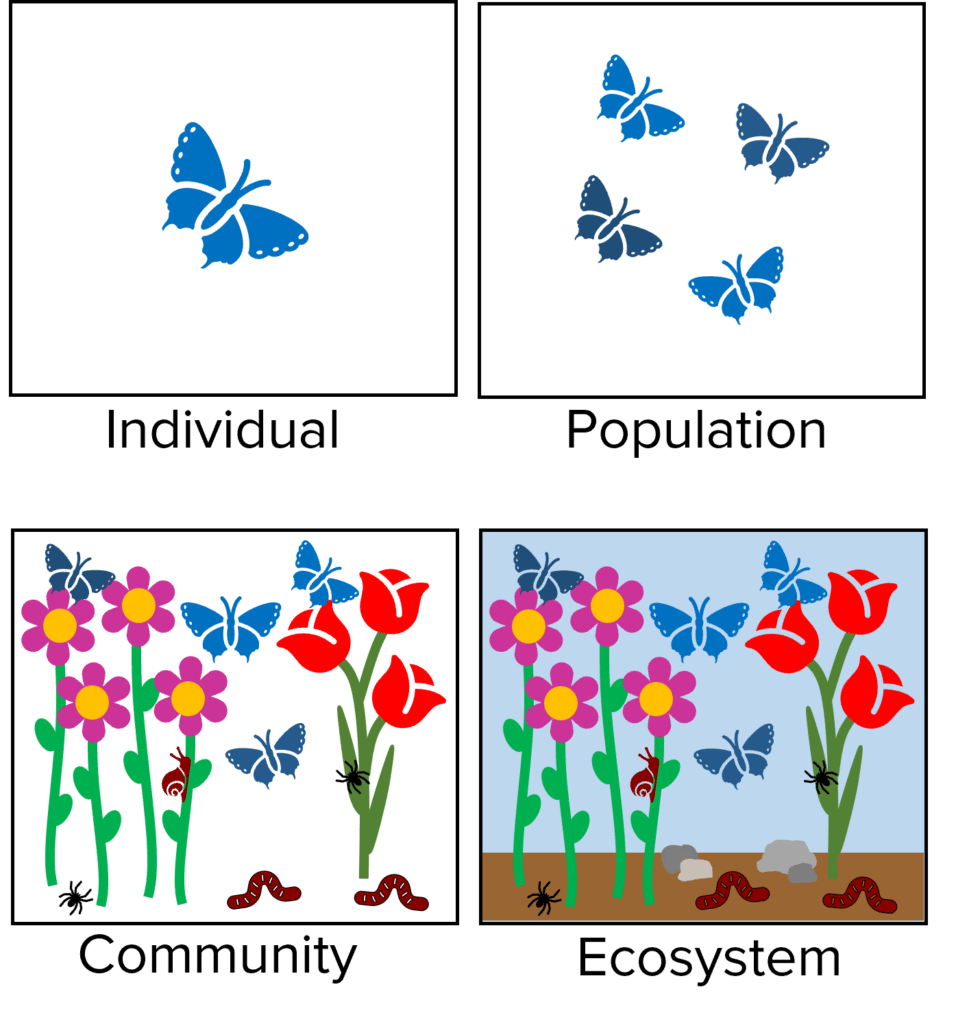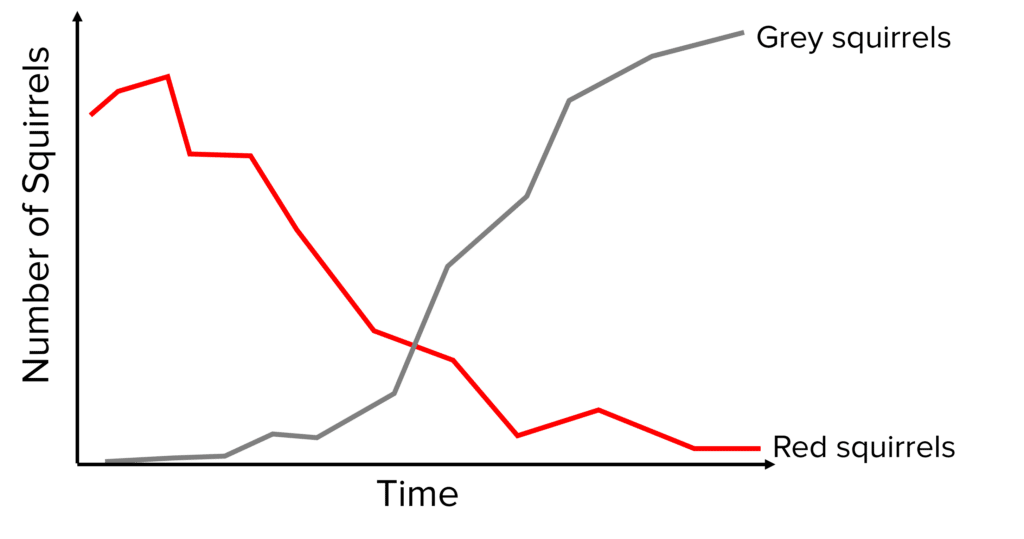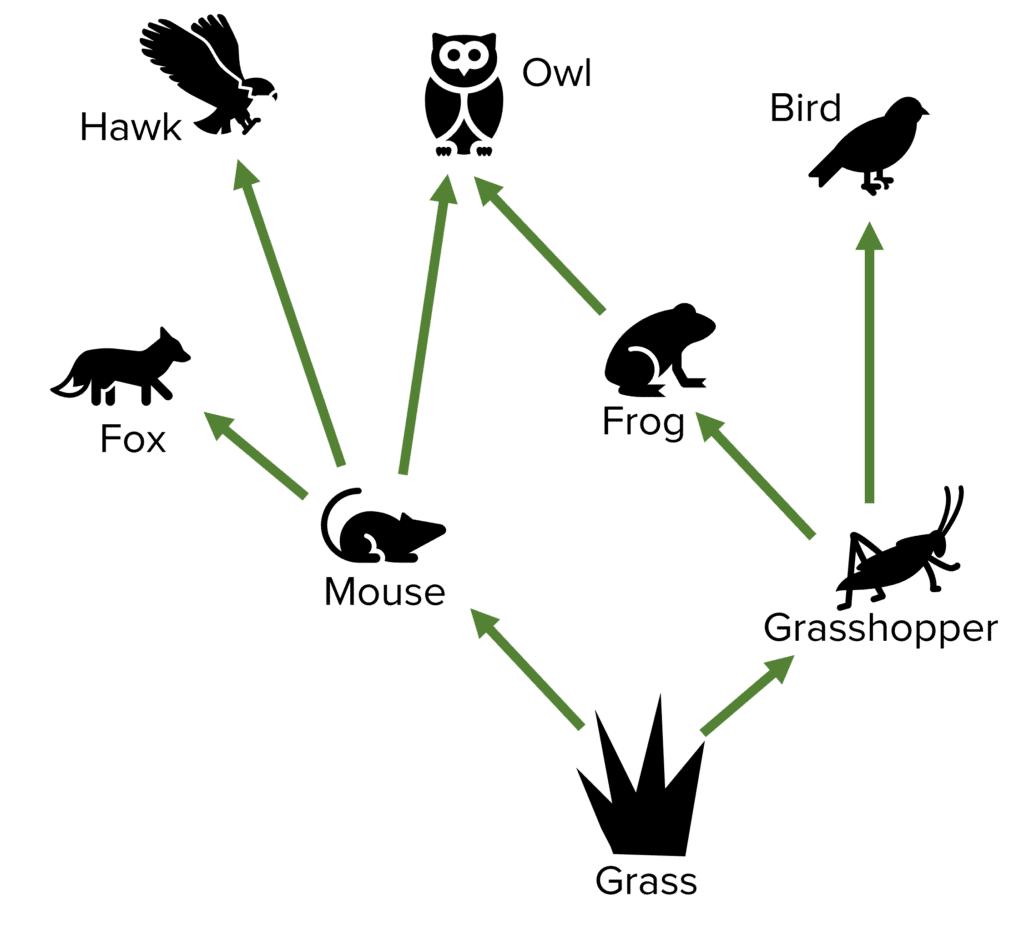Ecosystems
Ecosystems Revision
Ecosystems
Ecosystems are made up of communities of organisms that interact with their environment. Communities are affected by biotic factors like food availability and competition and abiotic factors like light intensity, temperature and amount of water. Species rely on each other to survive so changes to a population in a community can have knock-on effects on the other species, this is called interdependence. Organisms are often adapted to survive in the conditions in which they live. Extremophiles are bacteria who are adapted to live in extreme conditions.
Key words

It is important that you learn and understand the differences between these key terms:
- Individuals of the same species can breed together to produce fertile offspring.
- Organisms live in habitats.
- All the individuals from one species living in a habitat is called a population.
- Populations of different species that all share the same habitat make up a community.
- The community interacts with the environment in an ecosystem.
- The ecosystem is affected by biotic (living) factors and abiotic (non-living) factors.
Abiotic Factors
Abiotic factors are non-living factors that can interact with the community and affect the ecosystem.
Examples include:
- Light intensity – Increasing light intensity will increase the rate of photosynthesis in plants.
- Temperature – Animals and plants grow the best at their optimum temperatures.
- Moisture/ water levels – Plants and animals require the correct amount of water.
- pH of the soil – Different plants will grow best in different soil acidities.
- Soil mineral levels – Plants require lots of minerals to grow healthily.
- Direction and intensity of the wind – Wind speed can affect transpiration and photosynthesis rates in plants. Organisms may also move to find shelter from the wind.
- Levels of carbon dioxide – Plants need lots of carbon dioxide for photosynthesis.
- Levels of oxygen – Some aquatic animals can only survive if there is lots of oxygen dissolved in the water.
A change in an abiotic factor can affect the whole community.
Example:
If the soil water content is too low, plants will struggle to grow and animals who feed on the plants will be without food. This may cause them to migrate, use other food sources or in some cases cause death. This will have knock-on effects on the rest of the food chain.
Biotic Factors
Biotic factors are living factors that can influence an ecosystem.
Examples include:
- Availability of food – Organisms require food to survive and reproduce. Populations thrive when there is lots of food available.
- Introduction of new predators – In balanced communities, there is enough prey for the predators to feed on, without wiping out a whole prey population. If new predators arrive this balance can be shifted and there may not be enough prey to go around.
- Introduction of new pathogens – Populations will have no immunity or resistance to new diseases which can can lead to increased deaths until resistance evolves.
- Competition – Different organisms compete for the same resources. If some organisms are better at acquiring the shared resource than others, they will out compete the less adapted organism until there is no longer enough of them left to breed. Animals often compete for food, water, mates and territory. Plants often compete for light, space, water and mineral ions.
A change in one biotic factor can affect the whole community.

Example:
Grey squirrels were introduced into the UK in the late 1800s. They have since outcompeted the native red squirrels for food and other resources. As the number of grey squirrels increased, the number of red squirrels decreased, as seen in the graph on the right.
Interdependence
Species within a community rely on each other to survive, e.g. for food, shelter, pollination, seed dispersal. If one of these species is removed from the community, it can have significant effects on the other species, this is called interdependence.
When all the species and environmental factors are balanced the population sizes stay the same and the community is said to be stable.

Example:
The image on the right is a food web showing the feeding relationships between different species in an ecosystem. A change in the population of one species will have knock-on effects on other species in the food web.
If there is a new disease in the ecosystem that kills all of the frogs, there will be less competition for grasshoppers so the bird population will increase in size. However, there will be less food for owls so their population size will decrease. Mice will also be eaten more by owls so their population will decrease. If there are less mice, there will be less food for hawks and foxes so their population sizes will also decrease.
Adaptations
Organisms have features that make them more likely to survive in certain environments, these are called adaptations. They occur as a result of evolution and can be structural, behavioural or functional.
- Structural adaptations are physical features of an organism’s body. Animals may be coloured in a way that enables them to camouflage in the environment, making it easier to hide from predators or stalk their prey. Animals that live in cold places, like seals and whales, have a thick layer of fat called blubber and a small surface area to volume ratio that helps them retain heat. Animals that live in hot places, like camels, often have a thin layer of fat and a large surface area to volume ratio to increase heat loss.
- Behavioural adaptations are those that cause an organism to act/behave in a certain way. Many animals migrate to warmer places in the winter to avoid cold conditions in which they may struggle to survive.
- Functional adaptations affect the processes that occur inside an animals body. Many predators produce venom to help kill their prey and defend themselves. Desert animals conserve water by sweating very little and producing small amounts of concentrated urine. Some animals hibernate over winter to conserve their energy for spring, when they will need it to hunt for food.
Some bacteria are adapted to be able to live in extreme conditions, they are called extremophiles. This includes living in places that are extremely hot (volcanic vents), under high pressure (deep sea vents) and with a high salt concentration (salt lakes).
Ecosystems Example Questions
Question 1: What is the definition of a community?
[2 marks]
Populations of different species that share the same habitat.
Question 2: Name 2 abiotic factors and 2 biotic factors that could affect the number or distribution of organisms in an ecosystem.
[4 marks]
Abiotic, any 2 from:
- Light intensity.
- Temperature.
- Moisture/ water levels.
- Soil pH.
- Soil mineral levels.
- Direction and intensity of the wind.
- Carbon dioxide concentration.
- Oxygen concentration.
Biotic, any 2 from:
- Food availability.
- New predators.
- New pathogens.
- Competition.
Must state which is abiotic and which is biotic.
Accept sensible alternatives.
Question 3: What are the 3 types of adaptations that organisms can have?
[3 marks]
Structural, behavioural and functional.
Ecosystems Worksheet and Example Questions
Abiotic and Biotic Factors Questions
GCSEOfficial MMEAdaptations Questions
GCSEOfficial MMECommunities Questions
GCSEOfficial MMEOrganising an Ecosystem
GCSEOfficial MME
MME Premium Membership
£19.99
/monthLearn an entire GCSE course for maths, English and science on the most comprehensive online learning platform. With revision explainer videos & notes, practice questions, topic tests and full mock exams for each topic on every course, it’s easy to Learn and Revise with the MME Learning Portal.
Sign Up Now




